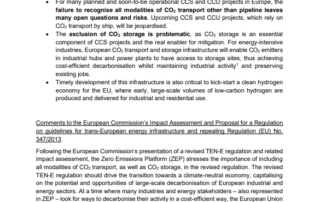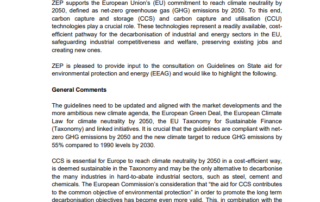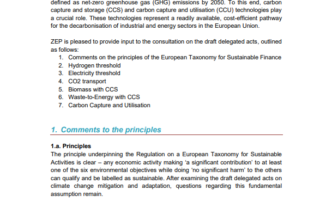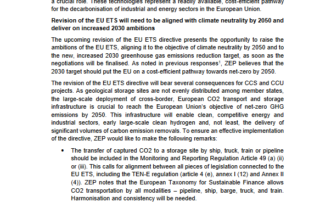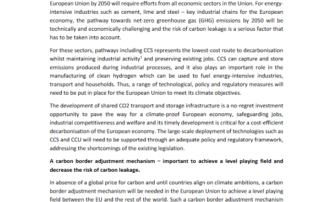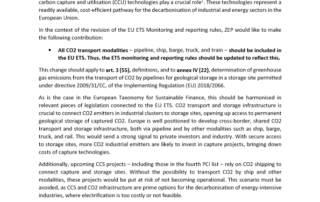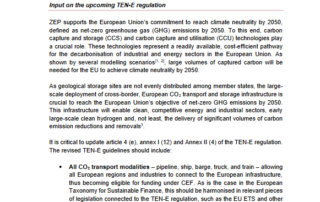ZEP response to the adopted act: Proposal for a Regulation on guidelines for trans-European energy infrastructure and repealing Regulation
ZEP responded to the consultation on the revised TEN-E Regulation, highlighting several key messages on carbon dioxide networks, CO2 transport modalities, CO2 storage, and the timely development of CO2 transport and storage infrastructure to kick-start a clean hydrogen economy for the EU, where early, large-scale volumes of low-carbon hydrogen are produced and delivered for industrial and residential use.
ZEP response to consultation on the Guidelines on State aid for environmental protection and energy
The guidelines need to be updated and aligned with the market developments and the more ambitious new climate agenda, the European Green Deal, the European Climate Law for climate neutrality by 2050, etc. CCS is essential for Europe to reach climate neutrality by 2050 in a cost-efficient way and may be the only alternative to decarbonise the many industries in hard-to-abate industrial sectors, such as steel, cement and chemicals. The European Commission’s consideration that “the aid for CCS contributes to the common objective of environmental protection” in order to promote the long term decarbonisation objectives has become even more valid.
ZEP response to consultation on EU Taxonomy’s delegated acts
ZEP is pleased to provide input to the consultation on the draft delegated acts, outlined as follows: 1. Comments on the principles of the European Taxonomy for Sustainable Finance 2. Hydrogen threshold 3. Electricity threshold 4. CO2 transport 5. Biomass with CCS 6. Waste-to-Energy with CCS 7. Carbon Capture and Utilisation
ZEP response to EU ETS Inception Impact Assessment
Revision of the EU ETS will need to be aligned with climate neutrality by 2050 and deliver on increased 2030 ambitions. The upcoming revision of the EU ETS directive presents the opportunity to raise the ambitions of the EU ETS, aligning it to the objective of climate neutrality by 2050 and to the new, increased 2030 greenhouse gas emissions reduction target, as soon as the negotiations will be finalised. As noted in previous responses, ZEP believes that the 2030 target should put the EU on a cost-efficient pathway towards net-zero by 2050.
ZEP response to consultation on Carbon Border Adjustment Mechanism
Achieving climate neutrality will prove to be an unprecedented challenge for the European Union. As the European Climate Law states, reaching the objective of climate neutrality within the European Union by 2050 will require efforts from all economic sectors in the Union. For energy-intensive industries such as cement, lime and steel – key industrial chains for the European economy – the pathway towards net-zero greenhouse gas (GHG) emissions by 2050 will be technically and economically challenging and the risk of carbon leakage is a serious factor that has to be taken into account.
REDII inception impact assessment
With the European Green Deal and the objective of climate neutrality by 2050, the European Commission has a possibility to review all related pieces of legislation. This is an opportunity to remove overlaps or contradictions between existing policies and to fully focus on the net-zero target and GHG emissions reduction. By introducing legislation that is directly compatible with net-zero and focused on GHG/CO2 threshold-driven measures, the energy and climate transition will be more cost-efficient, providing a clearer framework for industry and EU regions to plan and realise their decarbonisation pathways.
ZEP response to the consultation on EU Emissions Trading System
ZEP supports the European Union’s commitment to reach climate neutrality by 2050, defined as net-zero greenhouse gas (GHG) emissions by 2050. To this end, carbon capture and storage (CCS) and carbon capture and utilisation (CCU) technologies play a crucial role. In the context of the revision of the EU ETS Monitoring and reporting rules, ZEP has provided a response, stating that all CO2 transport modalities – pipeline, ship, barge, truck, and train – should be included in the EU ETS.
ZEP response to the revision of the Trans-European Energy Infrastructure (TEN-E) regulation
ZEP supports the European Union’s commitment to reach climate neutrality by 2050, defined as net-zero greenhouse gas (GHG) emissions by 2050. To this end, carbon capture and storage (CCS) and carbon capture and utilisation (CCU) technologies play a crucial role. As geological storage sites are not evenly distributed among member states, the large-scale deployment of cross-border, European CO2 transport and storage infrastructure is crucial to reach the European Union’s objective of net-zero GHG emissions by 2050. This infrastructure will enable clean, competitive energy and industrial sectors, early large-scale clean hydrogen and, not least, the delivery of significant volumes of carbon emission reductions and removals.

